Evaluation of the Memory Kernel of VACF
in Simulated Ni
20
Zr
80
-Liquids
Achmad Benny Mutiara #1 and Rina Refianti #2
# Faculty of Computer Science and Information Science, Gunadarma University
Jl. Margonda Raya No.100, Depok 16424, West-Java, Indonesia
1 [email protected] 2 [email protected]
Abstract—Based on Sjoegren und Sjoelander’s Mode-Coupling(MC)-Model, we have calculated the memory kernel (MK) of the Velocity Autocorrelation Function (VACF) in simulated Ni20Zr80-liquids. We have also constructed the memory kernel of VACF for our binary system, instead of one for one atomic system of the Sjögren und Sjolander’s model. The data required for the theoretical calculations have been obtained from molecular dynamics (MD) simulations. The theoretical results then are compared with those directly obtained from computer simulation. Although it exists a qualitative agreement between theoretical predictions and simulation results, we found that quantitatively there is an deviations between both results, especially for Zr-subsystem.
Keyword-Mode Coupling Theory, Molecular Dynamics Simulation, Liquids, Memory Kernel, NiZr
I. INTRODUCTION
Work in the last decade has provided evidence that MCT is able to describe the slow dynamics of fragile
liquids in the weakly supercooled state [1]. The work of Kob et.al.[2] has also showed that theory able to accurately describe the non-ergodicity parameters of simple as well as of network-forming liquids. The one important statement of the MCT is that the dynamics processes at long times is driven by a memory kernel which is included in MCT’s integro-differential equation.
In
previously paper [3,
4,5] we have studied the memory kernel of incoherent intermediate scattering function in glass-forming systems, namely Cu60Ti20Zr20-alloy and Ni20Zr80-alloy. Further, we have comparedthe memory kernels , evaluated from the MCT formula with the kernels , from inverting the time evolution of the intermediate scattering functions. The comparison shows encouraging agreement at 900 to 1100 K while significant deviations are found at 1200 K. It is an open question whether for this temperature an improved agreement between calculated , and estimated , can be obtained by inclusion of the coupling to transversal currents in the memory kernel formula as provided, e.g., by Gudowski et.al. [6].
The main objective of paper is to give one of the answer of above open question. But instead of the memory kernel of incoherent intermediate scattering function, we investigated the memory kernel of the velocity autocorrelation function (VACF) for temperature 1500 K. By calculating the memory kernel we included
all coupling as proposed by Sjoe
gren und Sjoe
lander’s Mode-Coupling(MC)-Model [7]. The calculated memory function then is compared with the kernel from inverting the time evolution of VACF.Our paper is organized as follows: Section 2 gives a brief discu
ssion of some aspects of the Sjoe
gren und Sjoe
lander’s Mode-Coupling(MC)-Model as used here. In Section 3, we present the model ofsimulation
and
computations. Results of our MD-simulations and their analysis are then presented and discussed in Section 4.II. SJOEGREN-SJOELANDER’S MODE COUPLING MODEL
As we know, the VACF can be studied through the formalism developed by Zwanzig and Mori [10], which is based on a following integral equation:
′ ′ (1)
In this paper the Sjögren und Sjolander’s (SS) Mode-Coupling(MC)-Model [7] is used. In this model the memory kernel of VACF was proposed for a simple liquid according to a combination of kinetic and mode coupling concepts.
(2) According to SS-Model the mode-coupling effects take into account four different coupling-term:
density-density coupling, two contributions from density-density-longitudinal current couplings, and density-density-transverse current coupling (s. Sjögren (1980/81) [11, 12], Gudowski et.al. (1993) [6], Canales et.al. (1997) [13]).
To compute the memory kernel of VACF, we follow method used by Sjögren (1980/81), Gudowski et.al. (1993), Canales et.al. (1997). If by these authors one atomic systems only were investigated, here we investigate a binary system. Also we have to develop and construct the formulation of coupling terms for our binary system.
Here are the results of our reformulation of for our binary system. The binary term is defined by [14]
Ω exp / , (3)
where Ω is the Einstein-frequency of -component [15],
Ω ∑ (4)
and can be determined by the following equation
Ω
0 (5)
The coupling terms is expressed by
. (6)
Here describes the density-density coupling, and the density-longitudinal currents couplings, and the density-transverse current coupling.
The Laplace transforms of these terms can be written
, (7)
, (8)
, (9)
, (10)
where und are repectively the Laplace transform of the binary term and the total memory kernel. The Laplace transform of the total Memory kernel is as follows
/ (11)
with
1 (12)
where are the Laplace transform of ”recollision” terms . Assuming isotropic systems can be expressed as follows
∞
, , , (13)
with
, , 2 ,
, ; (14)
Ω
∞ ′
, , , (15)
with
′ , ′ ,
′ ,
′ , ;
(16)
Ω ∞
, , , (17)
with
, ,
2
,
, ;
(18)
Ω ∞
, , , (19)
with
, , 2 ,
, (20)
Here is the Fourier transform of direct correlation function, and are -dependent quantities, which are defined in Balucani [14]. , und , are the transverse and longitudinal current correlation functions of the - parts. , is the difference between , and , , where
, exp /2 expresses the free-particle-form of intermediate incoherent scattering function.
III.SIMULATIONS
The simulations are carried out as state-of-the-art isothermal-isobaric ( , , ) calculations. The Newtonian equations of
N =
1296 atoms (260 Ni and 1036 Zr) are numerically integrated by a fifth order predictor-corrector algorithm with time step Δ = 2.5 10 s in a cubic volume with periodic boundary conditions and variable box length L. With regard to the electron theoretical description of the interatomic potentials in transition metal alloys by Hausleitner and Hafner [8], we model the interatomic couplings as in [9] by a volume dependent electron-gas term and pair potentials adapted to the equilibrium distance, depth, width, and zero of the Hausleitner-Hafner potentials [8] for Ni20Zr80 [5]. For this model, simulations were startedthrough heating a starting configuration up to 2000 K which leads to a homogeneous liquid state. The system then is cooled continuously to various annealing temperatures with cooling rate ∂
= 1.
5x
1012 K/s. Afterwards the obtained configurations at various annealing temperatures (here 1500-800 K) are relaxed by carrying out additional isothermal annealing runs. Finally the time evolution of these relaxed configurations is modeled and analyzed. More details of the simulations are given in [5].IV.RESULT AND DISSCUSION
We have calculated the total memory kernel of VACF in range 0,024 4,796 Å . The input data are all correlation functions that are analyzed from MD data. For simplifying we have only calculated the memory kernel at 1500 K. The reason for this is, because (i) according to some authors, except binary term and density-density coupling, the other couplings could be neglected by lower temperature, i.e., the contribution of the other couplings are very small, and more smaller than the contribution of the binary term and density-density coupling [16], (ii) after our experience there is a coupling contribution which decays slowly at lower temperature. These slowly decays make us technically a problem by the Laplace transform of couplings.
The deviations between SS-models results and MD-results can also be shown by results in computing , e.g., on figures (3) and (4).
As shown in figures (1) and (2) the most significant contributions come from the density-density coupling, the second from the density-longitudinal current density coupling, and the least from the density-transverse current coupling.
Figure 1. Ni - .
Figure 2. Zr - .
Figure 4. Zr - Ψ / 0.
V. CONCLUSION AND FUTURE WORK
We have calculated the memory kernel of VACF based on SS-model at 1500 K. The parameters used by calculating have been produced from simulation. We have compared the SS-model’s results and MD-results. Both results show a qualitative agreement, although quantitatively there is a deviations between both results, especially for Zr-subsystem. These results are agreed with the general Mode Coupling Theory’s predictions [1], namely that the most significant contributions are resulted from the density-density coupling.
For the future work, this coupling could be investigated, whether this coupling should be always dominant or not, when the temperature of system is lowered, and especially when the temperature of system is near the critical glass temperature .
ACKNOWLEDGMENT
A.B.M. and R.R. gratefully acknowledges a financial support of the Gunadarma Foundations.
REFERENCES
[1] W. Götze, Complex dynamics of glass-forming liquids: a mode-coupling theory, (Oxford University Press, New York, 2009).
[2] F. Sciortino and W. Kob, Phys. Rev. Lett. , (2001).
[3] X.J. Han and H. Teichler, Phys. Rev. E 75, 61501 (2007).
[4] A.B. Mutiara and H. Teichler, Phys. Rev. E 64, 46133 (2001).
[5] A.B. Mutiara, Dissertation, Universität Göttingen (2000).
[6] W. Gudowski, M. Dzugutov und K.E. Larsson, Phys. Rev. E 47, 1693 (1993); J. Non-Cryst. Solids 156-158, 125 (1993).
[7] L. Sjögren and A. Sjölander, J.Phys. C: Solid State Phys. 12, 4369 (1979)
[8] Ch. Hausleitner and Hafner, Phys. Rev. B 45, 128 (1992).
[9] H. Teichler, phys. stat. sol. (b) 172, 325 (1992).
[10] R.W. Zwanzig, J. Chem. Phys. 33, 1338 (1960); H. Mori, Prog. Theor. Phys. 33, 423 (1965).
[11] L. Sjögren, J.Phys. C: Solid State Phys. 13, 705 (1980)
[12] L. Sjögren, Phys.Rev. A 22, 2866 (1981); ibid, Phys.Rev. A 22, 2883 (1981)
[13] M. Canales and J.A. Padro, J.Phys.: Condens. Matter 9, 11009 1997
[14] U. Balucani and M. Zoppi, Dynamics of the Liquid State, (Oxford Science Publications, Oxford, 1994)
[15] B. Bernu, J.-P. Hansen, G. Pastore, and Y. Hiwatari, Phys. Rev A 36, 4891 (1987); ibid. 38, 454 (1988).

